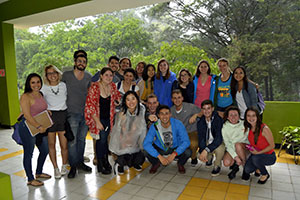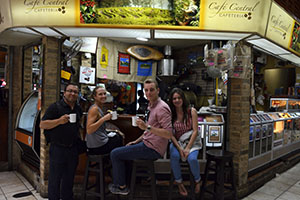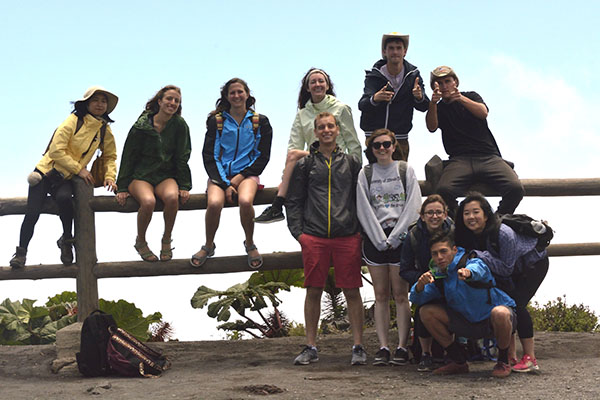 Illinois students participated in the first Chemistry study abroad program to Costa Rica.
Illinois students participated in the first Chemistry study abroad program to Costa Rica.
Pura Vida! is an expression “ticos” (people from Costa Rica) use constantly that literally means “pure life”. In many respects, visiting Costa Rica gives you the sense that locals have figured out how to enjoy life in its purest form. They also make really good chemists!
Between May 28 and June 10, a group of 11 Illinois students participated in the first Department of Chemistry study abroad program to Costa Rica under CHEM 492 Special Topics: Natural Products Research in Costa Rica.
Our host institution was the University of Costa Rica (UCR), specifically the Center for the Research of Natural Products (CIPRONA). The plan was to expose students to an aspect of research they would not be able to find inside cutting edge research facilities on campus at the University of Illinois. For this trip, the experience was the extraction of chemicals from plants collected directly from the tropical jungle.
Excitement had built up significantly prior to the trip after four discussion lectures on natural products chemistry, and tips on traveling abroad. As soon as the group arrived in Costa Rica, it was clear we were up for two weeks of fascinating discovery. Our hotel was “La Gran Casa Universitaria”, a big, old house right across the street from the University of Costa Rica.
A few blocks down the road was the School of Chemistry, which provided us with guides the first day: Verónica and Sebastian. These two students that together with several others from the Chemistry Students Association, became our dearest allies during the whole trip.
 As we entered CIPRONA, we were welcomed by Dr. Rosaura Romero, director of the center, and María Rios and Giovana Vechi, two doctoral students who, along with other members of the staff, assisted us in our journey of two weeks of planning and lab work. (This was, of course, accompanied every morning by the aroma of freshly brewed coffee.)
As we entered CIPRONA, we were welcomed by Dr. Rosaura Romero, director of the center, and María Rios and Giovana Vechi, two doctoral students who, along with other members of the staff, assisted us in our journey of two weeks of planning and lab work. (This was, of course, accompanied every morning by the aroma of freshly brewed coffee.)
Students were given a task by Dr. Santiago Sandí-Ureña to determine the species and the best method to obtain an extract of cúrcuma for potential commercialization. Curcuma (Curcuma longa), is a fast-growing plant with a rhizome (turmeric) in the family of ginger that is rich in curcuminoids that were the target of the study.
Curcumin, the main curcuminoid, is associated with antioxidant, anti-inflammatory and other desirable properties which has made it a valuable product in alternative medicine markets.
The first week involved group work to determine the best method to obtain such extract as well as the collection of a sample of cúrcuma. Both Illinois and Costa Rican students worked together to discuss literature procedures and possible routes their work would take to come up with the optimal proposal. This activity was the best way to ease the group into the subsequent lab work, as it allowed us to get into the rhythm of work at the center. For the sample collection, we visited the VerdEnergia permaculture farm, three hours away from the UCR campus, in the middle of the jungle. Joshua Hughes, who administers the farm, gave students a nice tour and explanation of their efforts on regenerating the top soil with fast-growing nitrogen-fixating species, such as cúrcuma. The visit to the farm was a great learning opportunity that motivated the students to be more curious and inquisitive.
 During the weekend, the group relaxed while visiting the Manuel Antonio National Park, where we could see monkeys and sloths, and other breathtaking landscapes at the beach as well as the Volcán Irazú National Park, which were all gorgeous sites to enjoy together.
During the weekend, the group relaxed while visiting the Manuel Antonio National Park, where we could see monkeys and sloths, and other breathtaking landscapes at the beach as well as the Volcán Irazú National Park, which were all gorgeous sites to enjoy together.
The second week demanded that students process their Cúrcuma samples for extraction. The group was divided into smaller groups that had the job of collecting an extract using three possible methods: hydrodistillation, stationary water/ethanol extraction or soxhlet. Analysis of the extracts was performed using UV-Vis and 1H NMR spectroscopy, which was a very impressive sample of the technological resources local students have available. Comparison of the methods was based on the quantification of total curcuminoids and curcumin in the extracts with respect to a calibration curve that was generated with an authentic sample of curcumin. Results allowed the students to propose a plan for scaling up the process, which would be necessary for a commercial venture.
As mentioned above, this activity was full of discovery and our students were able to witness the mobility of their knowledge as well as learning to collaborate with international colleagues. We are very happy to have visited beautiful Costa Rica and its warm people, but are sure we want to know more about the fascinating chemistry this tropical paradise has to offer. ¡Pura Vida!

José Andino Martinez